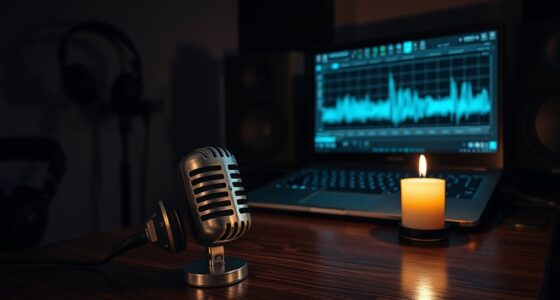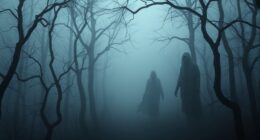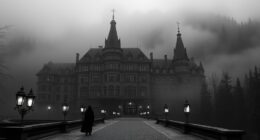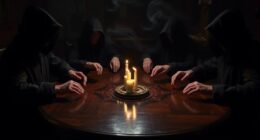Capturing ghosts on camera sparks curiosity and skepticism alike. The history of spirit photography shows how early images claimed to show spirits, often fueling debates over their authenticity. Modern techniques use infrared and digital tools, but many so-called ghost images are caused by artifacts like lens flare or double exposure. Scientific explanations point to natural causes, yet media sensationalism keeps the mystery alive. If you’re curious about the truth behind these haunting images, you’ll find more insights ahead.
Key Takeaways
- Many ghost images are caused by natural artifacts like lens flare, double exposure, or dust spots, not actual spirits.
- Modern techniques such as infrared imaging and AI tools can create or enhance paranormal-looking photos.
- Skeptics attribute most ghostly photos to technical errors or perceptual illusions, not supernatural entities.
- Recognizing photographic artifacts helps differentiate genuine paranormal captures from misinterpretations.
- Media sensationalism amplifies the belief that images depict spirits, blurring the line between reality and fiction.
A Brief History of Spirit Photography

Have you ever wondered how spirit photography first captured public imagination? It all began in the late 19th century, when photographers claimed to capture spiritual symbolism—images of spirits or loved ones who had passed away. These photographs often showed faint, ghostly figures alongside living subjects, sparking widespread fascination. However, the rise of spirit photography also raised questions about photographic ethics. Skeptics argued that many images were staged or manipulated, challenging the authenticity of these claims. Despite controversy, spirit photography became a cultural phenomenon, blending spiritual beliefs with emerging photographic technology. It’s a fascinating chapter where faith, science, and ethics intersect, shaping how people viewed life after death and the power of the camera to reveal unseen worlds. Additionally, the development of analytical cookies during that era helped researchers analyze these images and understand their origins more critically, highlighting the importance of investigative techniques in evaluating photographic evidence. Furthermore, the controversy surrounding authenticity prompted advancements in photo verification methods, which continue to influence modern digital image analysis today. Interestingly, many of these early investigations also contributed to the evolution of forensic photography, laying groundwork for techniques used in present-day evidence analysis. This ongoing pursuit of truth emphasizes the importance of scientific scrutiny in distinguishing genuine spirit images from false ones.
Iconic Images That Sparked Paranormal Debates

Some images have become legendary not only for their eerie qualities but also for the heated debates they ignite about the supernatural. Ethereal apparitions captured in photographs often stir controversy, as viewers debate whether they’re genuine spirits or optical illusions. One famous example features ghostly figures wandering through haunted landscapes, like abandoned houses or fog-covered cemeteries. These haunting images evoke strong emotional reactions and fuel discussions about the existence of spirits. Skeptics argue that such photos are manipulated or misinterpreted, while believers see them as undeniable proof of the supernatural. Regardless of their authenticity, these iconic images have left a lasting impression, sparking curiosity and skepticism. They continue to challenge our understanding of reality and the possibility of unseen worlds lurking just beyond our perception.
Techniques and Tools Used in Modern Ghost Photography

Modern ghost photography employs a variety of techniques and tools to create eerie and compelling images. Infrared imaging is a popular method, capturing light beyond human vision to reveal spectral-like forms or anomalies not visible to the naked eye. This technique often produces ghostly figures that seem to float or shimmer in photographs. Digital manipulation is another key tool, allowing photographers to enhance or alter images to emphasize paranormal effects. Using software, you can add ethereal glows, soften edges, or layer multiple exposures to craft convincing or unsettling scenes. These techniques enable you to experiment with visual effects that heighten the sense of mystery. While some skeptics dismiss these methods, they remain at the core of many modern paranormal images, blurring the line between reality and illusion. Additionally, emerging AI-driven tools are now being used to analyze and generate paranormal imagery, further expanding the possibilities in ghost photography. The integration of encryption solutions and secure data handling can also help protect the authenticity of digital images from tampering and unauthorized modifications. Incorporating sound design techniques, such as subtle audio cues or ambient sounds, can also enhance the overall eeriness and viewer engagement in multimedia ghost investigations. Exploring spectral phenomena through various digital tools allows enthusiasts to better understand and document paranormal activity. Many professionals also utilize regional legal resources to ensure their investigations and image sharing comply with local laws and regulations, maintaining ethical standards.
Common Photographic Artifacts and Misinterpretations

Many ghost sightings in photos are actually caused by artifacts like lens flare effects or sensor dust spots. Double exposure illusions can also make images look haunted when they’re just accidental overlaps. Recognizing these common issues helps you distinguish real mysteries from photographic misinterpretations. Additionally, understanding photo artifacts can reveal how aftermarket modifications might create visual effects that resemble paranormal phenomena. Awareness of AI image processing techniques is also useful, as they can sometimes introduce or enhance such artifacts unintentionally. Being familiar with camera sensor behavior can further aid in identifying false positives caused by technical anomalies, especially when combined with knowledge of sensor dust and its impact on image quality.
Lens Flare Effects
Lens flare effects occur when bright light sources, such as the sun or artificial lights, directly hit your camera lens, creating streaks, circles, or haze in your photos. These artifacts can resemble a ghostly apparition, leading some to interpret them as supernatural phenomena. However, lens flare is a natural result of light scattering within the lens elements, not a sign of spirits. To minimize unwanted flare, you can use a lens hood or change your angle to avoid direct light. Sometimes, photographers intentionally use lens flare creatively to add atmosphere or drama. Recognizing the difference between genuine anomalies and lens flare helps you avoid misinterpretations. Understanding water-related phenomena can help distinguish between real paranormal activity and photographic artifacts. What appears as a spooky figure might just be a common photographic artifact rather than a paranormal presence.
Double Exposure Illusions
Double exposure illusions occur when two images are combined in a single photograph, either intentionally or accidentally. You might see ghostly figures or layered scenes that seem surreal or unexplainable. Digital manipulation makes creating these illusions easier, allowing artists to blend images seamlessly for artistic expression. Sometimes, accidental double exposures happen during film development or camera settings, leading to confusing artifacts. These illusions can evoke mystery or evoke a sense of the supernatural, but often, they’re simply clever compositions or technical errors. Recognizing the difference between deliberate double exposures and accidental artifacts helps you interpret images more accurately. Whether used creatively or encountered unexpectedly, double exposure illusions challenge your perception, blurring the line between reality and imagination in photography.
Sensor Dust Spots
Have you ever noticed small, dark spots appearing in your photos that seem out of place? Those are likely sensor dust spots, tiny particles stuck on your camera’s sensor. They create spots that look like digital clutter, distracting from your shot’s clarity. Instead of mysterious ghosts, what you’re seeing are artifacts caused by sensor dust. These spots are common, especially after changing lenses or cleaning the sensor. To fix them, you can use sensor cleaning tools or editing software. Recognizing sensor dust helps prevent misinterpretations of your images. Don’t worry—these spots aren’t supernatural; they’re just a part of digital clutter that’s easy to address. Keep your sensor clean, and your photos will stay sharp and ghost-free.
| Sensor Dust | Digital Clutter |
|---|---|
| Tiny particles | Unwanted spots |
| Cause confusion | Misinterpretation |
| Easy to clean | Fix with software |
| Common in photos | Not paranormal |
Scientific Perspectives and Skeptical Analyses

While many enthusiasts interpret mysterious images as evidence of supernatural phenomena, scientific perspectives demand rigorous scrutiny. Often, what appears as ghostly figures results from natural factors like electromagnetic interference, which can distort camera sensors or create false images. Researchers also explore quantum entanglement, but its application to ghost photography remains speculative at best. Skeptics argue that pareidolia—the tendency to see familiar shapes—explains most paranormal images. Additionally, environmental conditions, low light, and camera settings contribute to illusions mistaken for spirits. Scientific analyses emphasize reproducibility and control, which ghost photos rarely demonstrate. Overall, these explanations highlight how natural phenomena and human perception, rather than supernatural forces, account for the mysterious images captured on camera.
The Cultural Impact of Ghostly Images in Media

Ghostly images have profoundly influenced popular culture, shaping how society perceives the supernatural and the unknown. These images often carry spiritual symbolism, representing messages from beyond or serving as signs from the afterlife. Media sensationalism amplifies their impact, turning everyday photos into paranormal phenomena that captivate audiences. This sensationalism fuels beliefs in ghosts and the supernatural, blurring the line between reality and fiction. You might find yourself questioning whether these images are genuine or manipulated, yet their cultural power remains undeniable. Films, TV shows, and social media perpetuate the idea that ghostly visuals hold deep spiritual meaning, reinforcing our fascination with the unseen. As a result, ghostly images become cultural symbols, influencing traditions, beliefs, and the collective imagination about life after death.
Frequently Asked Questions
Can Advanced Editing Software Create Convincing Ghost Images?
Advanced editing software can definitely create convincing ghost images through digital manipulation. By carefully blending layers and adjusting transparency, you can produce optical illusions that resemble ghostly figures. Your skills in editing can make these images highly realistic, especially when you pay attention to detail and lighting. While some may see them as just illusions, with proper technique, your manipulated images can convincingly mimic the appearance of spirits or ghosts.
Are There Specific Camera Settings That Improve Ghost Capture?
You can improve ghost capture by adjusting your camera settings, especially using long exposure to allow more light and motion trails. Experiment with different camera angles to increase the chances of catching ghostly apparitions in your frame. Keep your camera steady on a tripod to avoid blurring. Combining these techniques enhances your chances of capturing elusive spirits, making your images more convincing and intriguing.
What Role Does Lighting Play in Ghost Photography?
Lighting is the secret weapon in ghost photography, turning the ordinary into the extraordinary. You manipulate light to create atmospheric effects that make spirits seem to shimmer and float. Proper light control enhances eerie shadows and highlights, making your photos come alive with supernatural presence. By skillfully using light manipulation, you can craft haunting images that draw viewers into a world where ghosts appear more real and mysterious than ever before.
Have Any Ghost Photos Been Conclusively Proven Real?
You might wonder if any ghost photos have been conclusively proven real. Historically, sightings and paranormal investigations often report compelling images, but definitive proof remains elusive. Skeptics argue many photos are misinterpretations or hoaxes. While some images seem convincing, no photo has yet been scientifically validated as proof of ghosts. Your best bet is to approach such evidence with curiosity but also critical thinking, recognizing the limits of current technology and understanding.
How Do Cultural Beliefs Influence Ghost Photography Interpretations?
You might notice that cultural beliefs shape how you interpret ghost photos, often influenced by superstitions and folklore ingrained in your community. These cultural symbols can make certain shapes or figures seem more ghostly or meaningful, even if they’re just coincidences. Your perception is deeply tied to your background, so what one culture sees as a spirit, another might dismiss as a trick of the light, highlighting how beliefs color our interpretations.
Conclusion
As you explore the world of ghost photography, remember it’s a delicate dance between truth and illusion. Like shadows dancing on a wall, these images can both intrigue and deceive. Whether you believe in spirits or see them as clever tricks of the lens, one thing’s certain: the mystery keeps the camera’s gaze alive, inviting you to look beyond what’s visible and question what truly lurks in the unseen.









